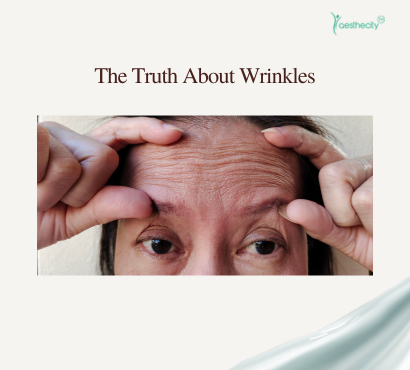Wrinkles are a natural part of aging, yet they are often met with concern and confusion. With countless treatments and skincare products claiming to reduce wrinkles, it’s essential to separate fact from fiction. In this comprehensive guide, we’ll explore what causes wrinkles, proven treatments that work, and common myths to avoid.
What Causes Wrinkles?
Wrinkles develop due to a combination of intrinsic and extrinsic factors:
Intrinsic Factors (Natural Aging)
- Reduced Collagen and Elastin: These proteins provide skin structure and elasticity. As production slows, skin becomes less firm and more prone to wrinkles.
- Decreased Oil Production: Aging skin produces less oil, leading to dryness and fine lines.
- Slower Cell Regeneration: As we age, skin cells regenerate at a slower pace, causing dullness and rough texture.
Extrinsic Factors (Environmental and Lifestyle)
- Sun Exposure: UV rays break down collagen and elastin, accelerating skin aging.
- Smoking: Reduces blood flow, damaging skin’s elasticity.
- Repetitive Facial Expressions: Frowning, squinting, and smiling can form dynamic wrinkles.
- Poor Nutrition: Lack of essential vitamins and antioxidants can weaken the skin.
- Stress and Sleep Deprivation: Inadequate rest impacts cell regeneration and hydration.
Proven Treatments for Wrinkles
Scientific advancements offer effective treatments that help reduce and prevent wrinkles. Here’s what works:
1. Retinoids (Vitamin A Derivatives)
- How They Work: Retinoids boost collagen production, accelerate cell turnover, and smooth out fine lines.
- Recommended Products: Tretinoin, Retinol, Adapalene.
- Best For: Reducing fine lines, improving skin texture, and evening skin tone.
2. Hyaluronic Acid (HA)
- How It Works: HA hydrates the skin by attracting moisture, plumping fine lines, and adding volume.
- Best For: Hydration, smoothing wrinkles, and enhancing skin elasticity.
3. Peptides
- How They Work: Peptides are amino acids that stimulate collagen production and repair damaged skin.
- Best For: Firming and tightening sagging skin.
4. Antioxidants (Vitamin C, E, and Green Tea)
- How They Work: Antioxidants neutralize free radicals, protecting skin from oxidative stress.
- Best For: Brightening skin, reducing pigmentation, and promoting an even tone.
5. Chemical Peels
- How They Work: Peels remove the damaged outer layer of skin, revealing smoother, younger-looking skin underneath.
- Best For: Treating fine lines, sun damage, and uneven texture.
6. Laser Treatments
- How They Work: Laser therapy stimulates collagen growth and tightens the skin.
- Best For: Deep wrinkles, acne scars, and skin resurfacing.
7. Botox and Dermal Fillers
- How They Work: Botox temporarily paralyzes facial muscles to reduce dynamic wrinkles, while fillers restore lost volume.
- Best For: Forehead lines, crow’s feet, and sagging skin.
8. Microneedling
- How It Works: Tiny needles create micro-injuries, triggering collagen and elastin production.
- Best For: Improving skin texture, reducing wrinkles, and minimizing scars.
9. Platelet-Rich Plasma (PRP) Therapy
- How It Works: PRP uses your blood’s platelets to promote healing and improve skin texture.
- Best For: Fine lines, wrinkles, and dull skin.
10. Lifestyle Modifications
- Healthy Diet: A diet rich in antioxidants, vitamins, and omega-3 fatty acids can enhance skin health.
- Hydration: Drinking plenty of water helps maintain skin elasticity.
- Sunscreen Use: Daily SPF protection prevents UV damage and premature aging.
Wrinkle Myths and Misconceptions
Not all anti-wrinkle claims are true. Here are some common myths debunked:
❌ Myth 1: Moisturizers Alone Can Eliminate Wrinkles
- While moisturizers improve skin hydration and temporarily reduce the appearance of wrinkles, they cannot reverse deep wrinkles on their own.
❌ Myth 2: Expensive Products Are Always Better
- Price doesn’t always indicate quality. Many affordable products containing effective ingredients like retinoids or hyaluronic acid can deliver impressive results.
❌ Myth 3: Natural Remedies are Always the Best
- While some natural oils may help with hydration, they often lack scientifically proven anti-aging benefits.
Preventive Measures for Wrinkles
In addition to effective treatments, adopting preventive measures can delay the onset of wrinkles:
✅ Daily Sunscreen Use (SPF 30 or higher)
✅ Staying Hydrated
✅ Maintaining a Balanced Diet
✅ Managing Stress
✅ Getting Enough Sleep
✅ Quitting Smoking
Wrinkles are a natural part of aging, but with the right skincare regimen and treatments, you can maintain youthful and healthy skin. By understanding what works and what doesn’t, you can make informed decisions to achieve radiant, age-defying skin.
FAQ
1. Can wrinkles be permanently removed?
Wrinkles can be reduced significantly with treatments like Botox, fillers, or laser therapies. However, natural aging will continue, requiring ongoing maintenance for long-term results.
2. At what age should I start using anti-aging products?
Starting preventive skincare in your mid-20s or early 30s can help delay the formation of wrinkles. Ingredients like retinol and antioxidants are ideal for this purpose.
3. Is Botox safe for reducing wrinkles?
Yes, when administered by a qualified professional, Botox is safe and effective. It’s commonly used for reducing forehead lines, crow’s feet, and frown lines.

